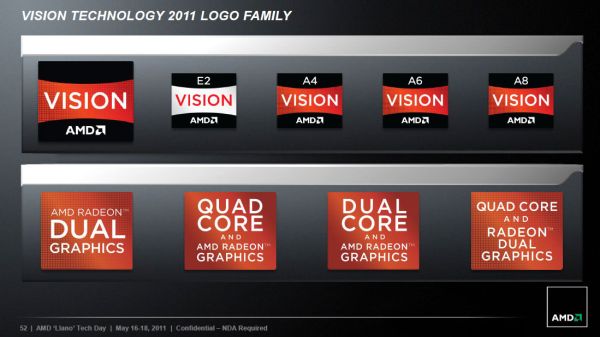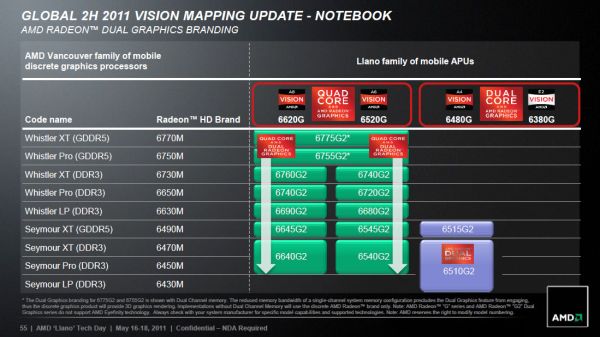The AMD Llano Notebook Review: Competing in the Mobile Market
by Jarred Walton & Anand Lal Shimpi on June 14, 2011 12:01 AM ESTIntroducing Mobile Llano
Anand has provided our coverage of Llano’s architecture and he’ll have a preview of desktop performance, but he’s leaving the mobile coverage to me (Jarred). At a high level, the breakdown of Llano is really quite simple: take a K10.5 series CPU core (dual- or quad-core), pair it up with a DX11 capable GPU core similar to AMD’s Redwood line (5600/5600M or 6500M), and then mix in power gating and Turbo Core; bake everything in a 32nm process and you’ve got Llano. Easier said than done, of course, as K10.5 parts previously used a 45nm process while Redwood used 40nm, so AMD had plenty of work to do before they could realize the simplistic overview I just described; the result is what matters, though, so let’s break out our spoons and see how the pudding tastes. Here’s the overview of the mobile A-series APUs launching today.
| AMD A-Series Fusion APUs for Notebooks | |||||||
| APU Model | A8-3530MX | A8-3510MX | A8-3500M | A6-3410MX | A6-3400M | A4-3310MX | A4-3300M |
| CPU Cores | 4 | 4 | 4 | 4 | 4 | 2 | 2 |
| CPU Clock (Base/Max) | 1.9/2.6GHz | 1.8/2.5GHz | 1.5/2.4GHz | 1.6/2.3GHz | 1.4/2.3GHz | 2.1/2.5GHz | 1.9/2.5GHz |
| L2 Cache (MB) | 4 | 4 | 4 | 4 | 4 | 2 | 2 |
| Radeon Model | HD 6620G | HD 6620G | HD 6620G | HD 6520G | HD 6520G | HD 6480G | HD 6480G |
| Radeon Cores | 400 | 400 | 400 | 320 | 320 | 240 | 240 |
| GPU Clock (MHz) | 444 | 444 | 444 | 400 | 400 | 444 | 444 |
| TDP | 45W | 45W | 35W | 45W | 35W | 45W | 35W |
| Max DDR3 Speed |
DDR3- 1600 DDR3L- 1333 |
DDR3- 1600 DDR3L- 1333 |
DDR3- 1333 DDR3L- 1333 |
DDR3- 1600 DDR3L- 1333 |
DDR3- 1333 DDR3L- 1333 |
DDR3- 1333 DDR3L- 1333 |
DDR3- 1333 DDR3L- 1333 |
There are two different power envelopes for Llano right now: 35W and 45W. The former models end with an M while the latter end in MX. Don’t let the relatively high TDPs fool you, as similar to Intel we’re looking at maximum TDP while idle and low-load TDP will be far lower. Based on battery life, it appears that the entire test notebook consumes around 7.42W at idle. By comparison, a slightly larger dual-core SNB notebook consumes around 7.68W when idle, so we’re very close to parity at idle. As noted earlier, all APU models come with 1MB L2 cache per core, and Turbo Core allows for cores to clock up to higher values under the right circumstances. That could prove important, as clock-for-clock K10.5 cores can’t hope to keep up with Sandy Bridge, and Sandy Bridge parts are already clocking significantly higher.
On the CPU side of the equation, there are currently only dual-core and quad-core parts, so tri-core appears dead (or at least MIA for now). The other part of the APU is the GPU cores, and here there are three options. The A6 and A8 APUs are both quad-core, but A6 has 320 Radeon cores clocked at 400MHz compared to 400 cores at 444MHz—so the 6620G is potentially 40% faster. A4 APUs trim the GPU further, with 240 cores clocked at 444MHz, and they’re the dual-core parts. The 6620G could be up to 67% faster than 6480G, under the right circumstances. As Anand mentioned, right now all of the A-series APUs are coming from the “big Llano” die, but in the future we’ll see the A4 production shift to “little Llano” instead of using harvested die.
Vision and Radeon Branding
For 2011, AMD is simplifying their Vision branding with Llano, skipping the Premium, Ultimate, and Black modifiers and instead referring to the APU. Vision E2 refers to the dual-core E-series APUs, while the A4, A6, and A8 lines correlate directly with the A-series APUs. The Radeon brand continues as an important asset, so there will be sticker options to promote quad-core and dual-core CPUs with Radeon graphics. What about the Dual Graphics, though?
With the integrated GPU finally able to approach the performance of midrange mobile GPUs, AMD is making a return to hybrid CrossFire (IGP and a dGPU working together), though the official name is now apparently “Radeon Dual Graphics” or just "Dual Graphics"; we’ve also heard it referred to as “Asymmetrical CrossFire”, and we’ll use any of these terms throughout this article.
We first saw an attempt at hybrid CrossFire with the HD 2400 and the 790 chipset, and later that extended to HD 3400 cards, but it never really impressed as it was limited to desktops and you could still get far better performance by spending an extra $10 to upgrade from a 3400 to a 3600 dGPU. The 6620G fGPU is several times more powerful than the old HD 4250 IGP, making CrossFire potential useful, especially on laptops where the power savings from shutting off the dGPU are very significant.
With Radeon Dual Graphics, AMD introduces more brands. The various Fusion GPUs (fGPUs) only work in CrossFire with specific discrete GPUs (dGPUs)—nearly all of the 6400M, 6600M, and 6700M line are eligible—giving rise to several new Radeon names. If you start with a base of a Radeon HD 6620G and add a Radeon HD 6770M to it, the resulting combination is now called a Radeon HD 6775G2. Pair it with a 6750M and you get a 6755G2. The entirety of the list is depicted in the slide from above. For now these names are just going to be listed on the notebook spec sheet, the drivers themselves will report the actual GPU you have driving the panel you're connected to. AMD is still working out the right way to expose these names through software to avoid confusion.












177 Comments
View All Comments
Brian23 - Tuesday, June 14, 2011 - link
Jarred/Anand,Based on the benchmarks you've posted, It's not very clear to me how this CPU performs in "real world" CPU usage. Perhaps you have it covered with one of your synthetic benchmarks, but by looking at the names, it's not clear which ones stress the integer vs floating point portions of the processor.
IMO, a test I'd REALLY like to see is how this APU compares in a compile benchmark against a C2D 8400 and a i3 380M. Those are both common CPUs that can be used to compare against other benchmarks.
Could you compile something like Chrome or Firefox on this system and a couple others and update the review?
Thanks! I appreciate the work you guys do!
ET - Tuesday, June 14, 2011 - link
PCMark tests common applications. You can read more details here: http://www.pcmark.com/wp-content/uploads/2011/05/P...While I would find a compilation benchmark interesting, are you suggesting that this will be more "real world"? How many people would do that compared to browsing, video, gaming? Probably not a lot.
Brian23 - Tuesday, June 14, 2011 - link
Thanks for the link. I was looking for something that described what the synthetic benchmarks mean.As for "real world," it really depends from one user to the next. What I was really trying to say is that no-one buys a PC just to run benchmarks. Obviously the benchmark companies try to make their benchmarks simulate real world scenarios, but there's no way they can truly simulate a given person's exact workload because it's going to be different from someone else's workload.
If we're going down the synthetic benchmark path, what I'd like to see is a set of benchmarks that specifically stresses one aspect of a system. (i.e. integer unit or FPU.) That way you can compare processor differences directly without worrying about how other aspects of the system affect what you're looking at. In the case of this review, I was looking at the Computation benchmark listed. After reading the whitepaper, I found out that benchmark is stressing both the CPU and the GPU, so it's not really telling me just about the CPU which is the part I'm interested in.
Switching gears to actual real world tests, seeing a compile will tell me what I'm interested in: CPU performance. Like you said, most people aren't going to be doing this, but it's interesting because it will truly test just the CPU.
JarredWalton - Tuesday, June 14, 2011 - link
Hi Brian,I haven't looked into compiling code in a while, but can you give me a quick link to a recommended (free) Windows compiler for Chrome? I can then run that on all the laptops and add it to my benchmark list. I would venture to say that an SSD will prove more important than the CPU on compiling, though.
Brian23 - Tuesday, June 14, 2011 - link
Jarred,This link is a user's quick how-to for compiling chrome:
http://cotsog.wordpress.com/2009/11/08/how-to-comp...
This is the official chrome build instructions:
http://dev.chromium.org/developers/how-tos/build-i...
Both use Visual Studio Express which is free.
I really appreciate this extra work. :-)
krumme - Tuesday, June 14, 2011 - link
The first links at the top is sponsored3 times exactly the same i7 + 460 ! ROFL
Then 1 i7 with a 540
Damn - looks funny, but at least it not 1024 *768 like the preview, but the most relevant resolution for the market - thank you for that
Shadowmaster625 - Tuesday, June 14, 2011 - link
Man what is it with this dumb yuppie nonsense. No I dont want to save $200 because I dont actually work for my money. Hell, if you're even reading this site then it is highly likely that the two places you want more performance from your notebook is games and internet battery life. All this preening about intel's crippled cpu being 50% faster dont mean jack because ... well its a crippled cpu. It cant play games yet it has a stupid igp. Why get all yuppity about such an obvious design failure, so much so that you'd be willing to sneeze at a $200 savings like it means nothing. It actually means something to people who work for a living. Most people just dont need the extra 50% cpu speed from a notebook. But having a game that runs actually does mean something tangible.madseven7 - Tuesday, June 14, 2011 - link
I'm not sure why people think this is such a crappy cpu. Am I missing something? Wasn't the Llano APU that was tested the lowest of the A8 series with DDR 1333? Doesn't it give up 500MHz-800MHz to the SB notebooks that were tested? Wouldn't the A8 3530mx perform much better? I for one would love to see a review of the A8 3530mx personally.ET - Tuesday, June 14, 2011 - link
Good comment. This is the highest end 35W CPU, but not the highest end Llano. So it gets commended for battery life but not performance. It will be interesting to see the A8-3530MX results for performance and battery life. It would still lose to Sandy Bridge quite soundly on many tests, I'm sure, but it's still a significant difference in clock speed over the A8-3500M..Jasker - Tuesday, June 14, 2011 - link
One thing that is really interesting that isn't brought up here is the amount of power used during gaming. Not only do you get much better gaming than Intel, but you also get much less power. Double whammy.